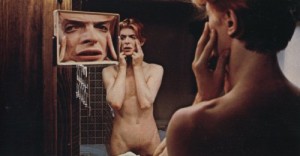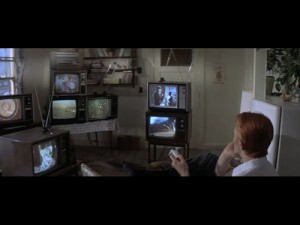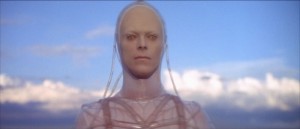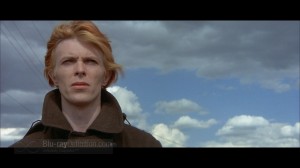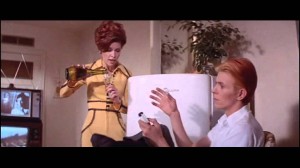From Monthly Film Bulletin No. 507, April 1976. –- J.R.
The Man Who Fell To Earth
Great Britain, 1976 Director: Nicolas Roeg
A stranger from another planet lands in New Mexico; calling himself Thomas Jerome Newton, he sells a series of rings to various jewellery stores and soon amasses a small fortune. He approaches Oliver Farnsworth, a homosexual lawyer in New York specializing in patents, shows him his plans for nine inventions destined to transform the communications industry, and concludes an agreement whereby Farnsworth supervises Newton’s World Enterprises Corporation and communicates with Newton, who wishes to maintain his privacy, chiefly by phone. Dr. Nathan Bryce, a chemical engineering professor, becomes intrigued by the corporation and decides to learn more about its master-mind. When Newton faints in an elevator, unaccustomed to the acceleration, the attendant, Mary-Lou, nurses him back to health and becomes his lover, tempting him into a taste for gin. After building a house on the lake where he landed and inaugurating a private space program, Newton hires Bryce as a consultant, and the latter discovers with a hidden X-ray camera that Newton s metabolism is not human. Newton intimates that he came to Earth because his race was dying from a lack of water and that his space program is designed to return him to his wife and children. But Newton is kidnapped shortly before his projected take-off by an organized syndicate represented by a Mr. Peters-who also orders Farnsworth killed after he declines the offer of a merger-and subjected to excruciating tests to determine his identity, which destroy his clairvoyant powers, until his captors give up and let him escape. Years later, Bryce, now living with Mary-Lou, tracks Newton down via a record album recorded incognito; now an alcoholic cripple but still showing no signs of aging, Newton admits that his planet would have treated a stranger no better.
A composite, all-purpose Nicolas Roeg extravaganza, The Man Who Fell to Earth bears visible echoes not only of Walkabout (Newton’s sentimental memories of his dying family on a parched planet), Performance (Newton with his TV sets recalling Mick Jagger with his sound equipment) and Don’t Look Now (the love scenes), but also Petulia, where Roeg served as a cameraman and the rudiments of his later methods are clearly set down. Basic to this approach is kaleidoscopic cross-cutting between diverse narrative strands, which tends to make simple plots appear relatively complex and relatively complex plots seem downright intractable. Pushing this tendency farther than ever before, his new film takes a rather straightforward s-f novel by Walter Tevis which could have been adapted any number of ways and then proceeds to run through vestiges of most of them, pursuing a steady succession of sideways ‘developments’ that remain obstinately undeveloped — most of them registering more like suggestive spurts than sustained forays — and leaving a veritable anthology of loose threads in their wake. Paul Mayersberg, who reportedly scripted a lot of varied material designed for subsequent Roeg manipulations, has hopefully described the results as a “circus”, but with the right elbow of the trapeze artist grafted on to the left ear of the clown which is then strained through the digestive tract of the lion and shot from a cannon, a more accurate description might be an extremely photogenic mess. The fact that whole sections of the plot are at best only semi-comprehensible — making the above synopsis by necessity a highly selective and interpretative account — is not altogether to the film’s discredit. Compared with the compulsive lucidity of a Ken Russell, who generally uses stylistic flourishes to hammer home the obvious, Roeg’s deft juggling of more diversified ingredients keeps his film watchable on a moment-to-moment level even when its implications veer straight towards banality. A random instance of this tendency can be found in the repetitive intercutting between (1) Newton being nursed back to health in his hotel room by Mary-Lou, (2) Bryce in bed with one of his students, and (3) Bryce in bed with another of his students whose remarks echo her predecessor’s — a sequence which juxtaposes at least three platitudes at such a frenetic shorthand pace that one is in little danger of suffering any of their consequences. And the proliferation of mystery questions leading into the narrative proper (Who is Newton? Who witnesses his landing? Who kidnaps him? etc.), then into the realm of metaphysics, and finally into the arms of a parable — Man’s inhumanity to and humanizing of the Unknowable – gives the film an engaging perpetual thrust, if little food for subsequent reflection. In a way, the only consistently unimpeachable source of fascination in the movie is David Bowie’s extraterrestrial persona and performance: genuinely uncanny with his asexual ambiance, surreal red hair, chiseled features and underplayed reactions, he offers one of the eeriest screen presences since Katharine Hepburn in Sylvia Scarlett (whom he oddly resembles in the last scene), and thanks to his centrality effectively provides a measuring-stick for the over wrought contributions of Rip Torn and Candy Clark and a contrast to the more conventional inertness of Buck Henry. Foundering on the notion that a maximum number of thematic vectors automatically guarantees an ‘open work’, Roeg and Mayersberg have blocked out most of the options in their design with dead ends. Yet Bowie bears the burden of this confinement so admirably that his monotonal expressive range paradoxically becomes the film’s one steady form of coherent expression – a cool, quivering reed at the center of a hurricane that is full of sound and fury, signifying nothing.
JONATHAN ROSENBAUM

